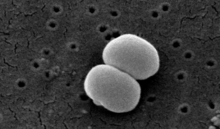
Back عنقودية بشروية Arabic عنقوديه بشرويه ARZ Staphylococcus epidermidis Bulgarian Staphylococcus epidermidis Catalan Staphylococcus epidermidis German Staphylococcus epidermidis Spanish Staphylococcus epidermidis Basque استافیلوکوکوس اپیدرمیدیس Persian Staphylococcus epidermidis Finnish Staphylococcus epidermidis French
| Staphylococcus epidermidis | |
|---|---|

| |
| Scanning electron image of S. epidermidis. | |
| Scientific classification | |
| Domain: | Bacteria |
| Phylum: | Bacillota |
| Class: | Bacilli |
| Order: | Bacillales |
| Family: | Staphylococcaceae |
| Genus: | Staphylococcus |
| Species: | S. epidermidis
|
| Binomial name | |
| Staphylococcus epidermidis (Winslow & Winslow 1908)
Evans 1916 | |
| Synonyms | |
|
Staphylococcus albus Rosenbach 1884 | |
Staphylococcus epidermidis is a Gram-positive bacterium, and one of over 40 species belonging to the genus Staphylococcus.[1] It is part of the normal human microbiota, typically the skin microbiota, and less commonly the mucosal microbiota and also found in marine sponges.[2][3] It is a facultative anaerobic bacteria. Although S. epidermidis is not usually pathogenic, patients with compromised immune systems are at risk of developing infection. These infections are generally hospital-acquired.[4] S. epidermidis is a particular concern for people with catheters or other surgical implants because it is known to form biofilms that grow on these devices.[5] Being part of the normal skin microbiota, S. epidermidis is a frequent contaminant of specimens sent to the diagnostic laboratory.[6]
Some strains of S. epidermidis are highly salt tolerant and commonly found in marine environment.[3] S.I. Paul et al. (2021)[3] isolated and identified salt tolerant strains of S. epidermidis (strains ISP111A, ISP111B and ISP111C) from Cliona viridis sponges of the Saint Martin's Island Area of the Bay of Bengal, Bangladesh.
Commensal S. epidermidis is an essential part of a healthy skin microbiota. It contributes through supporting a healthy skin barrier, healing cuts of the skin, protecting the skin microbiota from colonization of skin pathogens, and acting as an immune system modulator.[7]

- ^ Schleifer KH, Kloos WE (January 1975). "Isolation and Characterization of Staphylococci from Human Skin I. Amended Descriptions of Staphylococcus epidermidis and Staphylococcus saprophyticus and Descriptions of Three New Species: Staphylococcus cohnii, Staphylococcus haemolyticus, and Staphylococcus xylosus". International Journal of Systematic Bacteriology. 25 (1): 50–61. doi:10.1099/00207713-25-1-50.
- ^ Fey PD, Olson ME (June 2010). "Current concepts in biofilm formation of Staphylococcus epidermidis". Future Microbiology. 5 (6): 917–933. doi:10.2217/fmb.10.56. PMC 2903046. PMID 20521936.
- ^ a b c Paul SI, Rahman MM, Salam MA, Khan MA, Islam MT (2021-12-15). "Identification of marine sponge-associated bacteria of the Saint Martin's island of the Bay of Bengal emphasizing on the prevention of motile Aeromonas septicemia in Labeo rohita". Aquaculture. 545: 737156. doi:10.1016/j.aquaculture.2021.737156. ISSN 0044-8486.
- ^ Levinson W (2010). Review of Medical Microbiology and Immunology (11th ed.). pp. 94–99.
- ^ Salyers AA, Whitt DD (2002). Bacterial Pathogenesis: A Molecular Approach (2nd ed.). Washington, D.C.: ASM Press. ISBN 978-1-55581-171-6.
- ^ Queck SY, Otto M (2008). "Staphylococcus epidermidis and other Coagulase-Negative Staphylococci". Staphylococcus: Molecular Genetics. Caister Academic Press. ISBN 978-1-904455-29-5.
- ^ Landemaine L, Da Costa G, Fissier E, Francis C, Morand S, Verbeke J, et al. (2023). "Staphylococcus epidermidis isolates from atopic or healthy skin have opposite effect on skin cells: potential implication of the AHR pathway modulation". Frontiers in Immunology. 14: 1098160. doi:10.3389/fimmu.2023.1098160. PMC 10250813. PMID 37304256.